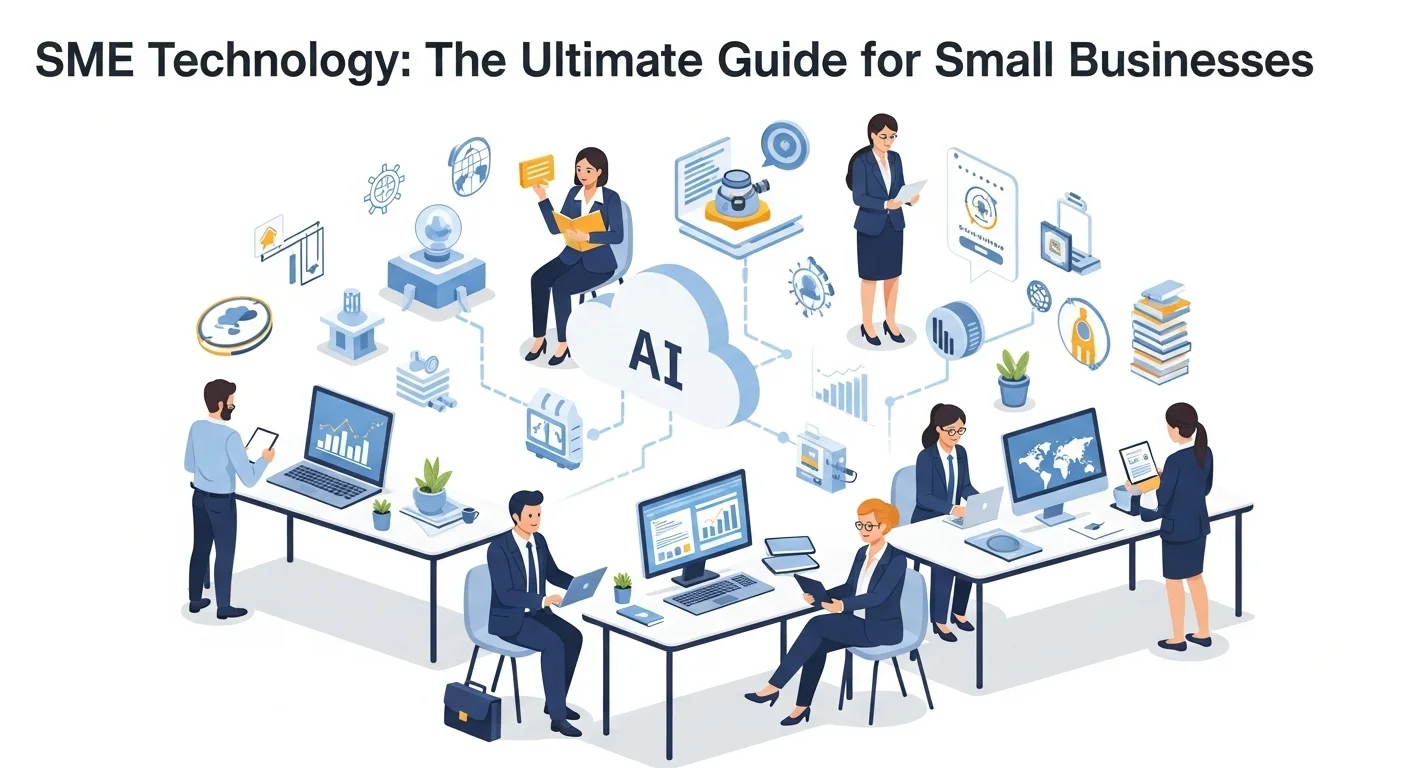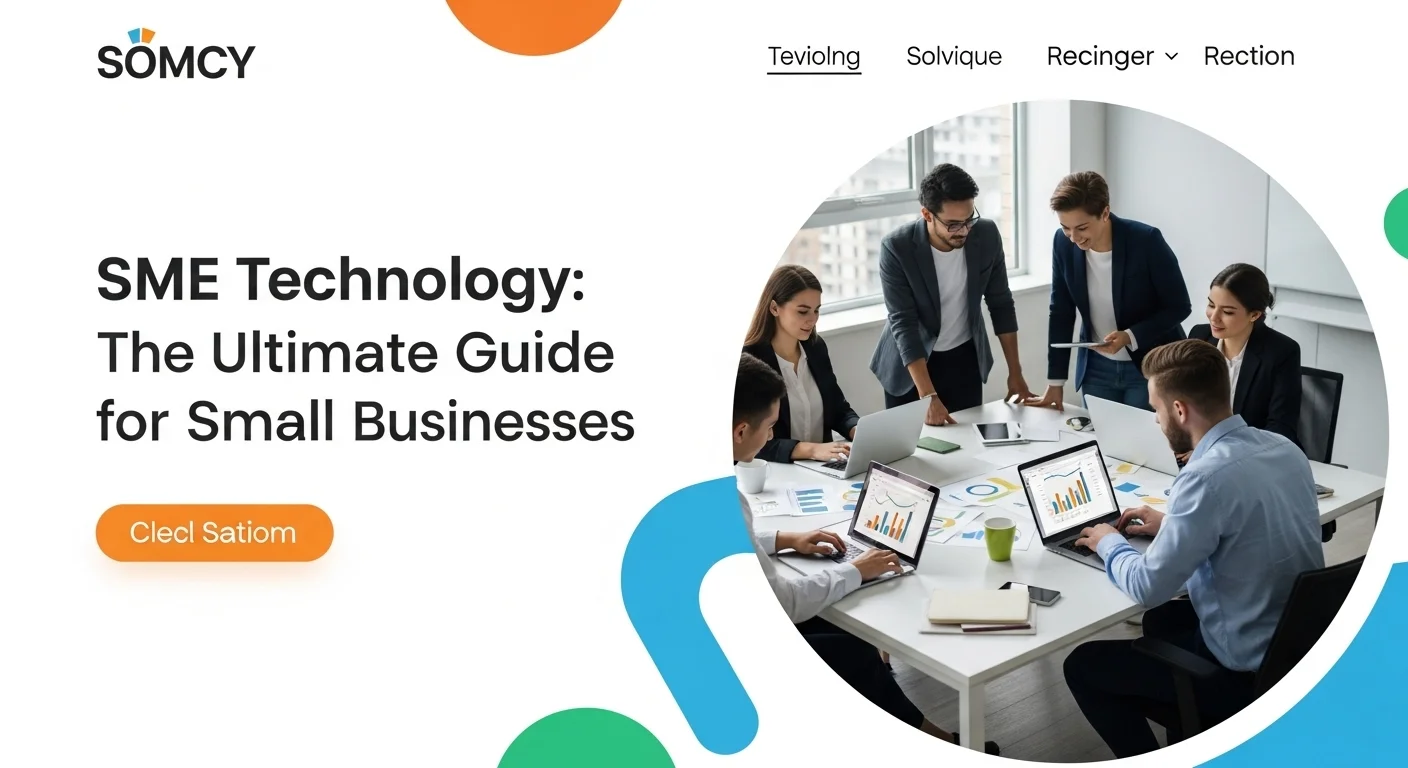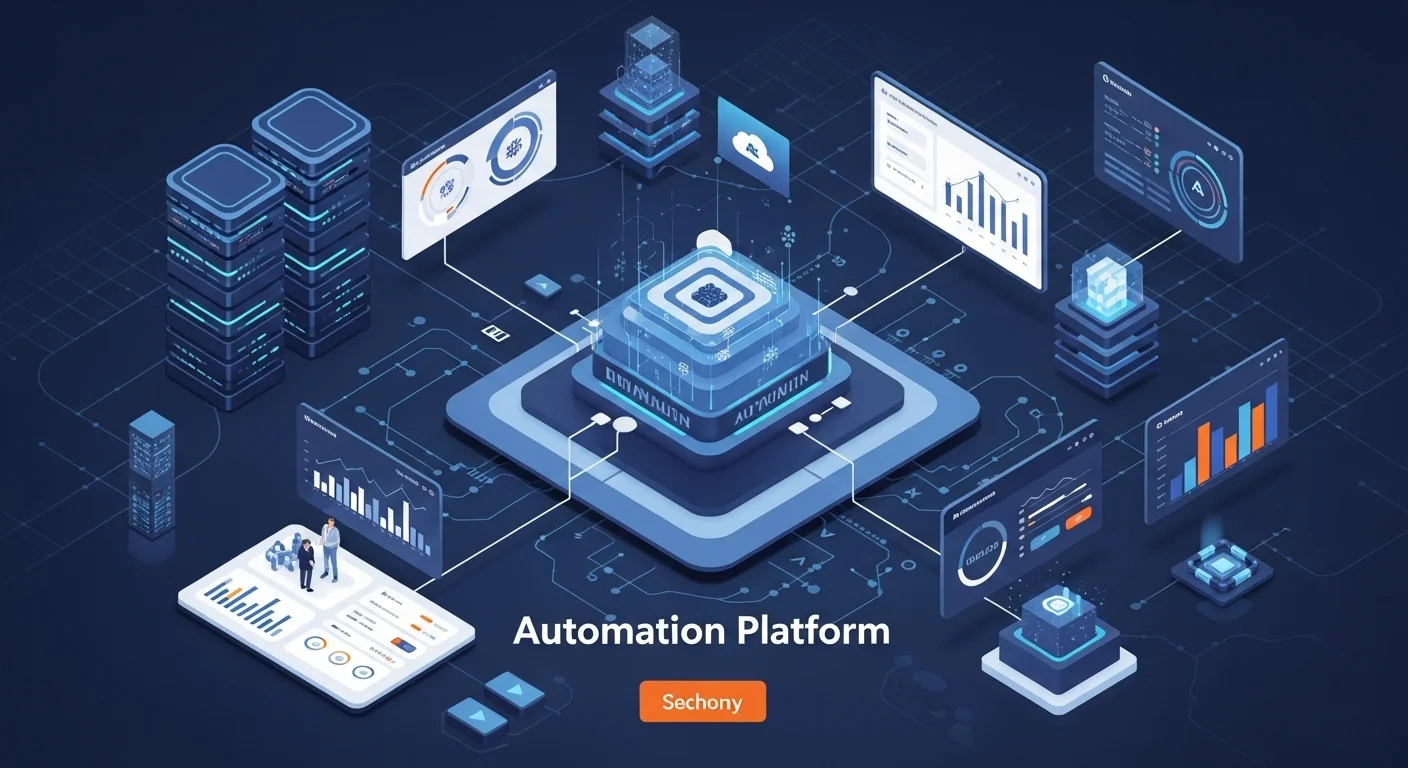Your SME's Guide to Technology: How Cloud and AI Can Transform Your Business

Executive Summary
In my years of helping small businesses, I've seen one thing change the game more than anything else: smart technology. It's no longer a luxury reserved for giant corporations; it's the engine that drives success for Small and Medium-sized Enterprises (SMEs) today. This guide is your friendly roadmap to understanding how tech can truly transform your operations. We'll break down the essentials, like how cloud solutions give you big-business power without the big-business price tag. We'll also dive into the exciting world of Artificial Intelligence (AI), showing you how it can automate tedious tasks and even help you secure a business loan. I wrote this for the hardworking business owners and curious entrepreneurs out there. We'll explore practical strategies and new business ideas that can turn technology into your greatest competitive advantage. Let's walk through how to navigate this digital world and unlock your business's full potential.
Table of Contents
Table of Contents
- What Is an SME, and Why Is Tech Their New Best Friend?
- Your Toolkit for Growth: Cloud, AI, and Cybersecurity Explained
- Putting It All Together: Practical Tech Strategies for Your SME
What Is an SME, and Why Is Tech Their New Best Friend?
Let's start with the basics. You've probably heard the term SME, which stands for Small and Medium-sized Enterprise. Honestly, it's just a formal way of describing the businesses that form the heart and soul of our economies. In Europe, that might mean a company with fewer than 250 employees. In the U.S., the SBA often considers businesses with under 500 employees to be 'small'. But forget the formal definitions for a second. What truly matters is their massive collective impact—SMEs make up around 90% of all businesses and create more than half of the jobs worldwide. They are the local shops, the innovative startups, and the family-owned factories that keep our communities thriving. I've always been drawn to their agility and passion. In today's world, their ability to grow, and even just to survive, is directly tied to how well they embrace technology. Technology is the great equalizer. It gives smaller companies access to tools and markets that were once completely out of reach, allowing them to compete with the big guys. For an SME, technology isn't just about efficiency; it's about unlocking potential. It lets you automate the boring stuff so you and your team can focus on what really matters—strategy and growth. With digital marketing, you can reach customers on the other side of the world. With data analytics, you can understand what your customers truly want and build real loyalty. This shift is what we call digital transformation, and it's a journey every modern SME needs to take. For many entrepreneurs I work with, this opens up a whole new world of SME business ideas. You could launch a specialized e-commerce store, build an app that solves a common local problem, or offer digital services to other businesses. The tools are more accessible and affordable than ever. Two pillars hold up this new world of opportunity: cloud computing and artificial intelligence. SME cloud solutions have been a complete game-changer. Instead of buying and maintaining expensive servers in a closet, you can now 'rent' storage, computing power, and top-tier software on a pay-as-you-go basis. This flexibility is incredible; you can scale up or down as your business changes. Whether it's using everyday tools like Google Workspace or building something custom on a platform like AWS, the cloud gives every SME access to enterprise-level power. Then there's the rise of the AI SME. Artificial intelligence sounds futuristic, but it's already here and incredibly practical. An SME AI strategy is about using smart tools to automate customer service with chatbots, create personalized marketing, or get predictive insights from your sales data. One of the most powerful applications I've seen is with AI in SME lending. Getting a loan has always been a major hurdle for small businesses. Traditional banks often see SMEs as risky. AI is changing that by looking at a wider range of data to assess a business's health more fairly and quickly. This makes it easier for deserving businesses to get the capital they need to expand. In short, embracing technology is no longer optional. From foundational SME cloud solutions to the innovative power of an SME AI, these tools offer a path to overcome old challenges and seize new opportunities. By exploring fresh SME business ideas and understanding things like AI in SME lending, you can build a resilient, thriving business for the future. The first step is realizing that today, every business is a tech business.

Your Toolkit for Growth: Cloud, AI, and Cybersecurity Explained
Diving into the world of technology can feel overwhelming, especially when you're busy running a business. But with a clear plan, you can turn these tools into your biggest allies. Let's break down the essential pillars of technology that every Small and Medium-sized Enterprise (SME) should focus on: cloud computing, artificial intelligence, and cybersecurity. Think of this as your essential tech toolkit.
Mastering SME Cloud Solutions
If I had to recommend one starting point, it would be the cloud. Cloud computing is the foundation of modern business tech because it offers incredible flexibility and saves you money. You don't need a huge upfront investment in hardware. Instead, you access what you need over the internet. It's like switching from owning a car to using a ride-sharing service—you only pay for what you use. It generally comes in three flavors:Infrastructure as a Service (IaaS)
Think of IaaS as renting the land and foundation for a house. You get the basic building blocks—virtual servers, storage, and networking—from providers like Amazon Web Services (AWS) or Microsoft Azure. This is perfect for businesses that need a powerful, flexible backbone for their website or custom applications, without the headache of managing physical machines.Platform as a Service (PaaS)
PaaS is like having a pre-built frame and utilities for your house. It gives your developers a platform—including operating systems and tools—to build, run, and manage applications without worrying about the underlying infrastructure. It helps you innovate faster and bring new SME business ideas to life.Software as a Service (SaaS)
SaaS is the fully furnished house you move right into. These are the ready-to-use software applications you subscribe to, and you probably use them already. Think Google Workspace for email and docs, Salesforce for customer management, or QuickBooks Online for your finances. For most businesses, these SME cloud solutions are a lifesaver because they're easy, affordable, and always up-to-date.Harnessing the Power of AI for SMEs
Artificial intelligence is your next big opportunity. An AI SME is simply a business that uses AI smartly to get ahead. The key is to start with practical, simple applications.Automate Your Customer Engagement
AI-powered chatbots can answer common customer questions around the clock, which frees up your team for more complex problems. I've seen small e-commerce shops dramatically improve their response times this way. AI can also scan online reviews and social media to give you honest feedback on what people love (and what they don't).Supercharge Your Marketing and Sales
An SME AI strategy can make your marketing so much smarter. Instead of guessing, you can use AI to analyze customer data, deliver personalized marketing messages, and even predict which sales leads are most likely to close. It's about making sure every marketing dollar you spend is working as hard as it can.The New Reality of AI in SME Lending
Getting funding is tough. That's where AI in SME lending is making a huge difference. Fintech companies and even traditional banks are now using AI to create a fairer and faster loan process. Instead of just looking at a credit score, AI models can analyze your business's real-time cash flow and transaction history to get a true picture of your creditworthiness. This means:- Faster Decisions: What used to take weeks can now take days or even hours.
- Better Access: Businesses without a long credit history can finally get a fair shot at securing a loan.
- Fairer Process: Well-designed AI can reduce human bias, leading to more objective lending decisions.
Don't Forget Cybersecurity
As you adopt more technology, you also need to protect yourself. Cybersecurity isn't just an IT issue; it's a business survival issue. A single breach can be devastating for an SME. Focus on the basics: train your team to spot phishing emails, use multi-factor authentication everywhere you can, and keep your software updated. It’s a non-negotiable part of any modern business strategy. By combining a solid foundation of SME cloud solutions with the smart application of SME AI, you can build a more efficient, insightful, and resilient business ready for whatever comes next.
Putting It All Together: Practical Tech Strategies for Your SME
Adopting new tech isn't about buying the latest gadgets. It’s about making strategic choices that help your business run smoother, empower your team, and deliver real results. For Small and Medium-sized Enterprises (SMEs), a smart plan can be the difference between struggling and thriving. Here are some practical tips I've shared with countless business owners to help them get the most out of their technology journey.
Start with a Clear Technology Roadmap
You wouldn't start a road trip without a map, so don't start investing in tech without a plan. A technology roadmap simply outlines where you want to go and how you'll get there.1. Know Where You Are
First, take an honest look at your current technology. What tools are you using? What’s working? What's causing frustration? Ask your employees for their input—they're the ones using these tools every day and often have the best insights.2. Align with Your Business Goals
Your tech strategy should directly support your business goals. Are you trying to boost sales by 15%? Improve customer response time? Cut operational costs? When your goals are clear, it's much easier to decide which tech investments will have the biggest impact.3. Prioritize and Budget Wisely
You can't do it all at once, and you don't have to. Focus on the initiatives that offer the most bang for your buck. And remember, think of technology as an investment in your future, not just another expense on your balance sheet.Best Practices for Adopting SME Cloud Solutions
Moving to the cloud is a huge step forward. To make sure it goes smoothly and you reap all the benefits of SME cloud solutions, here are a few things to keep in mind:1. Pick the Right Mix
You don't have to choose just one cloud model. Most SMEs I work with find success with a hybrid approach. They use SaaS for everyday applications like email and accounting, and maybe IaaS or PaaS for more specialized needs.2. Take Security Seriously
While cloud providers have excellent security, protecting your data is a shared responsibility. Make sure you use strong passwords, control who has access to what, and always encrypt sensitive data. A clear policy on how data is managed in the cloud is a must.3. Plan for Growth
One of the best things about the cloud is that it can grow with you. Choose SME cloud solutions that can easily scale. The last thing you want is to have to switch platforms right when your business starts taking off.Simple Strategies for a Successful SME AI Integration
Artificial intelligence can feel intimidating, but bringing it into your business doesn't have to be. For a successful AI SME, the key is to be strategic.1. Start Small, Win Big
Don't try to build a massive AI system overnight. Start with one specific problem you want to solve. For example, use an AI chatbot to handle after-hours customer questions or an AI-powered tool to analyze your marketing campaigns. Small, focused wins build momentum.2. Good Data In, Good Results Out
An AI is only as smart as the data it learns from. Before you launch any SME AI tool, make sure your data is clean and organized. It might take some effort up front, but I promise it's worth it.3. Bring Your Team Along
Your team's support is crucial. Train them on how the new tools work and, more importantly, how they will make their jobs easier. Frame AI as a helpful assistant that can handle tedious tasks, freeing them up for more creative and strategic work. Understanding the logic behind AI in SME lending can also be a great lesson in how data-driven decisions are made.Final Thoughts: Fostering New Ideas
Finally, use your newfound tech knowledge to innovate. Create a culture where new SME business ideas are encouraged. Technology makes it easier than ever to:- Test Ideas Quickly: Use low-code platforms to build a prototype of a new app without needing a huge budget.
- Reach New Customers: Leverage e-commerce and digital marketing to sell your products or services far beyond your local neighborhood.
- Create Data-Powered Services: Use your business data to offer valuable insights. A marketing agency, for example, could use AI to offer predictive sales forecasts to its clients.
Expert Reviews & Testimonials
Sarah Johnson, Business Owner ⭐⭐⭐
This was a good overview, but as a business owner, I was hoping for more step-by-step examples I could apply directly to my shop. A bit more practicality would be great.
Mike Chen, IT Consultant ⭐⭐⭐⭐
Solid article that covers all the key areas of SME tech. As an IT consultant, I found it accurate. Some of the technical concepts could be broken down even further for people who aren't tech-savvy.
Emma Davis, Tech Expert ⭐⭐⭐⭐⭐
Fantastic guide! It clearly explains how cloud and AI aren't just for big corporations anymore. This connected a lot of dots for me in my own research. I feel much more confident about our tech strategy now. Thank you!



